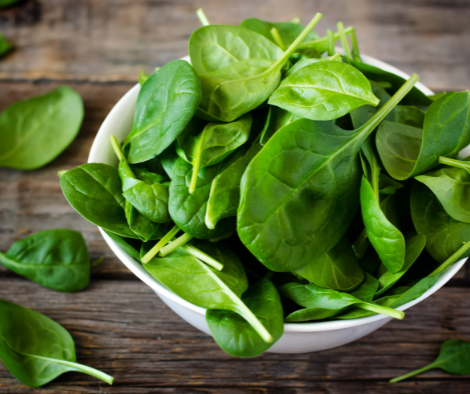Green Foods
If you remember your middle school biology class on photosynthesis, you might recall that Chlorophyll is what gives plants their green color. This little pigment provides some fantastic antioxidants to your bloodstream when you consume green veggies, and studies have shown that it also can be used to improve your skin health. Typically low in calories and high in nutrients, green foods are an everyday staple– whether you are on Phase 1 or in maintenance.
Let’s take a closer look at some of the other health benefits that green veggies provide, because there are MANY.
Spinach

Ideal Protein Phase
All phases
Significant Vitamins &Minerals
Vitamin A, Vitamin C, Vitamin K, iron, magnesium, potassium
I always thought that Popeye and the superpowers that he got from eating spinach were just a ploy to get me to eat more of the veggie when I was a kid, but the truth is that spinach really IS a superfood! Loaded with lots of vitamins and minerals (many of which we’ve already talked about) this leafy green packs a powerfully nutritious punch.
Magnesium, although found in many green veggies, is found in significantly higher numbers in spinach. In fact, one cup of cooked spinach contains nearly 40% of your Recommended Daily Intake (RDI) of the mineral. That’s a pretty nice deal when you consider that magnesium is involved in HUNDREDS of biochemical functions within your body. I especially appreciate magnesium for what it does when I exercise. Magnesium helps move blood sugar into your muscles and dispose of lactate, which can build up during exercise and cause fatigue. So, by eating spinach, I am preventing those aches and pains that exercise can cause in my body.
Speaking of aches and pains, spinach and the potassium it contains helps with that too. Potassium is an electrolyte that most people associate with bananas, but in one cup of cooked spinach (or three cups of raw), there is 25% more potassium than in a banana!
I personally love to have 3-4 cups of this raw veggie blended into my chocolate smoothie every morning, but no matter how I (or you) eat it, it’s definitely helping me out!
Kale

Ideal Protein Phase
All phases
Significant Vitamins & Minerals
Vitamin A, C, & K, Calcium, Potassium, Glucosinolates
Kale is king when it comes to being a nutrient-dense veggie. In fact, kale contains the most Vitamin A of all IP Phase 1 veggies. As you now know (if you’ve been reading about red and orange foods), sweet potatoes contain a huge amount of the vision-improving vitamin, but until you reach Phase 2, you can enjoy all the vitamin A your body needs for the day with a single cup of cooked kale (98% RDI). Kale also contends with another orange food when it comes to vitamin C. A cup of raw kale contains even more vitamin C than a whole orange. Kale also has TONS of vitamin K, a nutrient that helps your blood to clot when you get an injury. And though you might be trying to decide between eating kale and spinach, keep in mind that kale has more vitamin C and vitamin K than spinach
On another equally important note, kale actually contains bile acid sequestrants, which can lower cholesterol levels. This might lead to a reduced risk of heart disease over time. Kale has been shown to combat cancer, improve eye health, and (of course) increase weight loss through all of its many benefits. Honestly, there are so many of them, I couldn’t even list them all. Cooked or raw, blended or baked, kale is here to help you out! And just remember that even if you’re in Phase 1, you’re still more than able to get those essential vitamins and minerals that you need with this delicious leafy green.
Celery

Ideal Protein Phase
All phases
Significant Vitamins & Minerals
Vitamins A, C, & K, Folate, Potassium, Phthalides
While you won’t be eating this crunchy veggie with peanut butter or cream cheese during Phase 1, you are still able to experience its value in all IP phases. The green phytonutrients in celery have been shown to reduce instances of inflammation in the digestive tract, cells, blood vessels, and organs, and considering the high amounts of vitamins A, C, & K in celery, they help our bodies function well day-to-day.
However, some of the most valuable nutrients in celery are called phthalides, and they are very prominent within celery seed and its extract. This compound has been shown to lower blood pressure because it causes the walls of arteries to relax, promoting healthier blood flow. Studies indicate that eating celery and celery seed can therefore decrease your chances of stroke or heart attack. Another benefits of phthalides are that they have been shown to decrease memory loss and cognitive issues, and studies have demonstrated that it can improve learning deficits and spatial memory loss and might even be worthwhile in the prevention and/or treatment of Alzheimer’s disease.
Celery is definitely one of my go-to snacks, sprinkled with salt and pepper or smeared with almond butter (when in Phase 2), but it also makes a great addition to soups and salads!
Broccoli

Ideal Protein Phase
All phases
Significant Vitamins & Minerals
Vitamins A, C, & K, Fiber, Glucosinolates (sulforaphane,…)
Like kale, broccoli is a cruciferous vegetable, and as such, it has many micronutrients that benefit the body. However, it’s the glucosinolates within broccoli (and kale) that really make this filling veggie so beneficial. Once consumed, glucosinolates break down into other forms, several of which have been studied at length for their cancer-inhibiting qualities. These compounds have been shown to protect against cell damage, carcinogens, harmful bacteria, and various types of inflammation. Whether eaten cooked or raw, the benefits that we experience from consuming something so simple as broccoli are immense.
I personally love to steam or roast this veggie with a little olive oil, salt, and pepper, or maybe mix it with mushrooms and scallions and the protein of my choice for some delicious stir-fry!
Aasparagus

Ideal Protein Phase
All phases
Significant Vitamins & Minerals
Vitamins A, C, & K, Folate, Vitamin E, Quercetin
Although asparagus doesn’t have the levels of vitamins that more leafy greens contain, it still provides a substantial amount of nutritional benefits, and it is delicious to eat. Like other fruits and veggies, asparagus helps prevent inflammation, heart disease, cancer, and other diseases. However, there is one thing that asparagus does do for which I am VERY grateful, and that is help to prevent allergic reactions in your body! No joke!
Asparagus is particularly high in quercetin, a bioflavonoid that can prevent your immune system’s cells from releasing histamine. As a result, researchers think that quercetin may help reduce symptoms of allergies, including runny nose, watery eyes, hives, and swelling of the face and lips. Quercetin is more often found in fruits and the herbs sage and parsley than in vegetables, but considering that fruits are off limits during Phase 1, and I’m not partial to eating a bundle of herbs for my veggie intake every day, asparagus sounds like a great way for me to get this incredibly beneficial micronutrient into my system.
Roasted, boiled, baked, or grilled, I love chowing down on asparagus with olive oil, salt, pepper, and any other seasonings I can think of!




